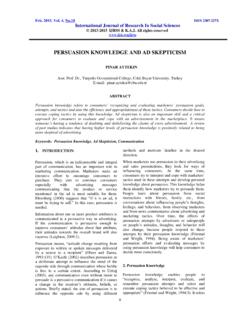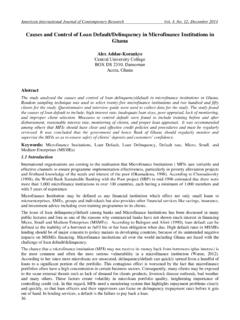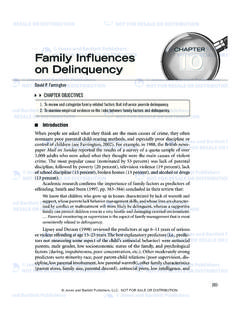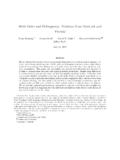Transcription of FACTORS INFLUENCING YOUTH CRIME AND …
1 March 2013. Vol. 1, ISSN 2307-227X International Journal of Research In Social Sciences 2012 IJRSS & All rights reserved 18 FACTORS INFLUENCING YOUTH CRIME AND JUVENILE DELINQUENCY John Onyango Omboto1.
2 Gerald O. Ondiek2, Odhiambo Odera3, Mary Evelyn Ayugi4 Department of Sociology, University of Nairobi, Kenya1 School of Business, University of Nairobi, Kenya2 University of Southern Queensland, Australia and Masinde Muliro, University of Science and Technology, Kenya (Email: Department of Sociology, University of Nairobi, Kenya4 ABSTRACT Effective solutions and prevention measures to social problems are easy to find when the root causes of such problems are established. For this reason, scholars have come up with several underlying FACTORS that influence criminality among the YOUTH and juvenile delinquency.)
3 This paper addresses these FACTORS among the YOUTH imprisoned at Kamiti YOUTH Corrective Training centre ( ) which is the only penal institution for young male offenders aged 17 21 years in Kenya. The study involved 55 inmates selected by simple random sampling method from a sample frame of 120 inmates. Out of the 55 respondents 31 were aged 17 years while the remaining 24 were aged between 18 and 21 years. The data was collected by the use of questionnaires and personal interviews. The need to pay more attention to the CRIME that involve the young people is further supported by the CRIME reports which indicate that a higher number of juveniles and the YOUTH have been involved in various crimes both in society and in learning institutions where unrests and riots are common.
4 Keywords: YOUTH CRIME , juvenile delinquency, Kenya POVERTY AND CRIME AMONG THE YOUTH Various observations indicate that most of the YOUTH are in CRIME because of poverty, which drove them into criminal acts for survival (Prior & Paris, 2005). At , the study revealed that over 70%; more than 40 out of 55 of the inmates were poor or came from poor family backgrounds based on where they lived, property ownership and the types of offences committed. For instance, some boys indicate that they had run from home to beg for survival in the streets because they lacked basic needs.
5 In those streets they latter committed crimes to survive, they were involved in petty offences like stealing goods or properties whose value were less than Kshs 500. This finding on poverty as a cause of CRIME among the young people confirms the opinion of Thomas R. Forstenzer, in his article Tomorrow in North America: YOUTH between the American dream and reality , in The Twentieth Session UNESCO General Conference Report titled - YOUTH in the 1980 s on poverty as a cause of deviance.
6 He observed that economic stress and a sense of personal failure is .. the chronic culprit for the symptoms of social decay: drugs, alcohol and sex related problems that will affect the young as long as the family itself has difficulty facing the strains of inflation and unemployment . As poverty dictates which social class an individual belongs to, it was observed that most of these YOUTH at belonged to the lower social class. A majority of these offenders at 45 out of 55, ( ) indicate that before their arrests, they lived in the various slums around Nairobi city such as Mathare, Kibera and Mukuru Kwa Njenga.
7 The researcher noted that a number of these offenders were bare footed. This observation on the influence of social class on CRIME and delinquency affirms the opinion of Wright & Younts (2009) that the delinquency rate increases with a decrease in social class. March 2013. Vol. 1, ISSN 2307-227X International Journal of Research In Social Sciences 2012 IJRSS & All rights reserved 19 DRUGS GREATLY INFLUENCE JUVENILE DELINQUENCY AND YOUTH CRIMINALITY Some
8 YOUTH get into CRIME due to peer pressure and rebellion against parental authority (Maseko, 2009). Cases of the young offenders whose offences were being in possession of bhang (cannabis sativa) were noted at YCTC and they confessed to have been recruited by friends. This reinforces Erickson (2001) observation that drugs also lead the YOUTH to CRIME . There were some YOUTH who claimed to have committed criminal activities under the influence of chang aa (traditional liquor) and bhang.
9 This confirms Dentler (1967) assertion that addiction to narcotics destroys the moral fibre of the addict; therefore, their character deteriorates and habits become evil. Makhoha (2008) in a study on the FACTORS that influence male delinquents to commit capital offences among Kamiti inmates established that drugs were one of the FACTORS . The cases of unrest in schools and colleges have also been attributed to drug abuse where bhang smoking is common. For instance, these riots and arson attacks in schools; where students are burnt in their sleep to death by their colleagues occurred in Endarasha Boys High on 18/10/2010 in Nyeri County when two students were burnt to death (Sunday Standard Newspaper, 19/10/2010).
10 At Kodero Bara Secondary School in Migori County, a fourteen-year-old form one boy died in a night fire that burnt a dormitory; ten students were questioned by the police over the February 2004 incident. There are many FACTORS that have been cited as the cause of these unrests include authoritarian school administration management, and lack of dialogue between the teachers and students. However, the National Agency for the Campaign against Drug Abuse (Nacada) in its October 2002 study recognizes the rampant drug abuse in learning institutions which is not limited to cannabis sativa.












